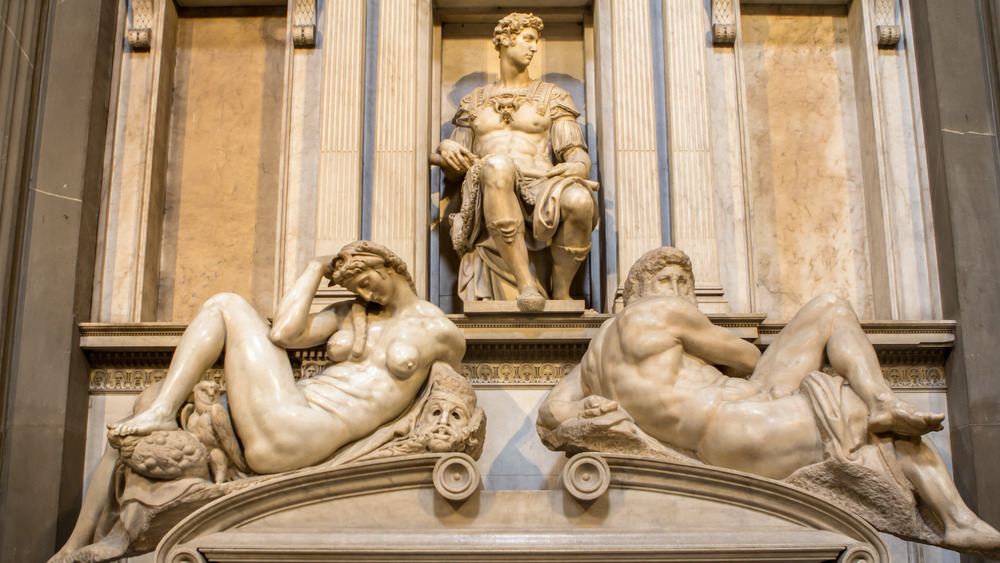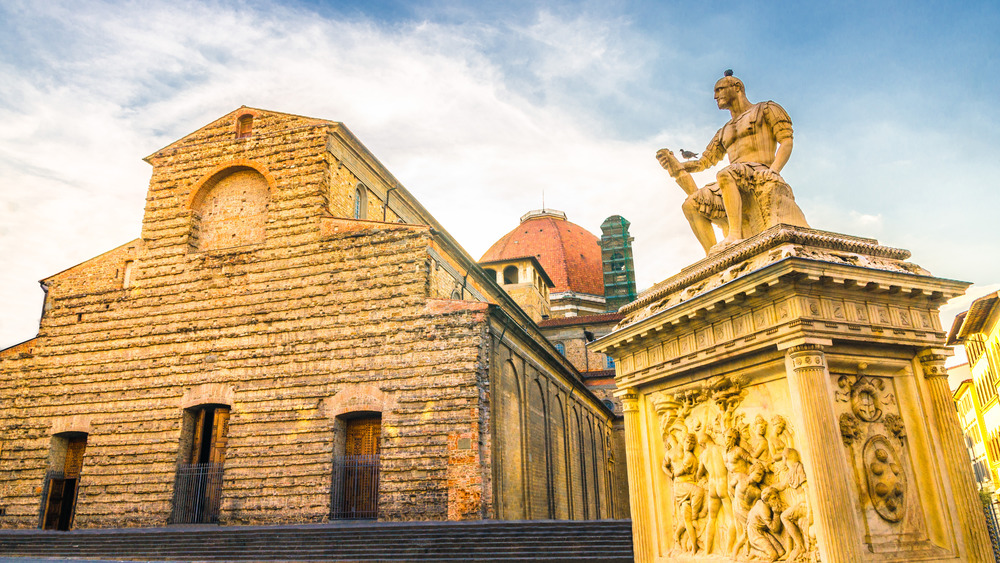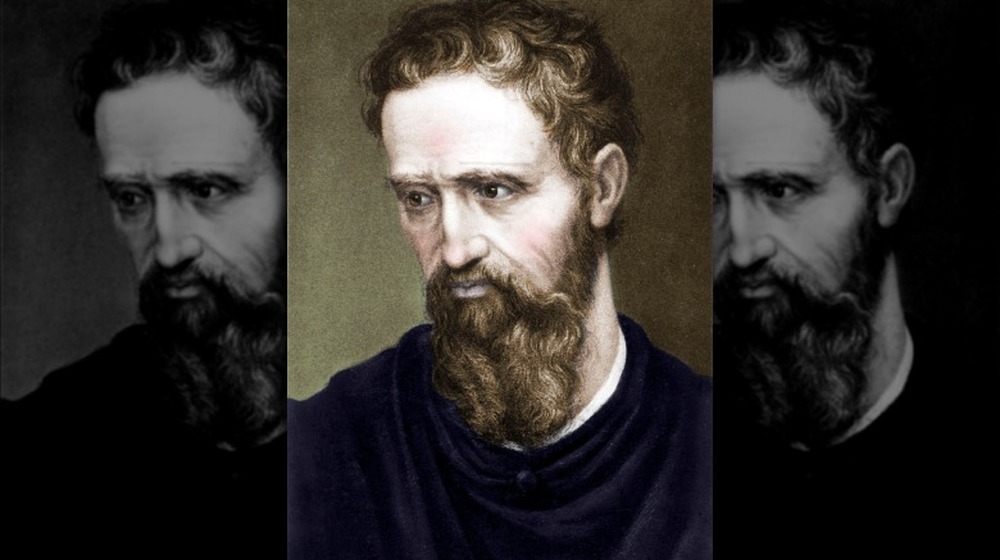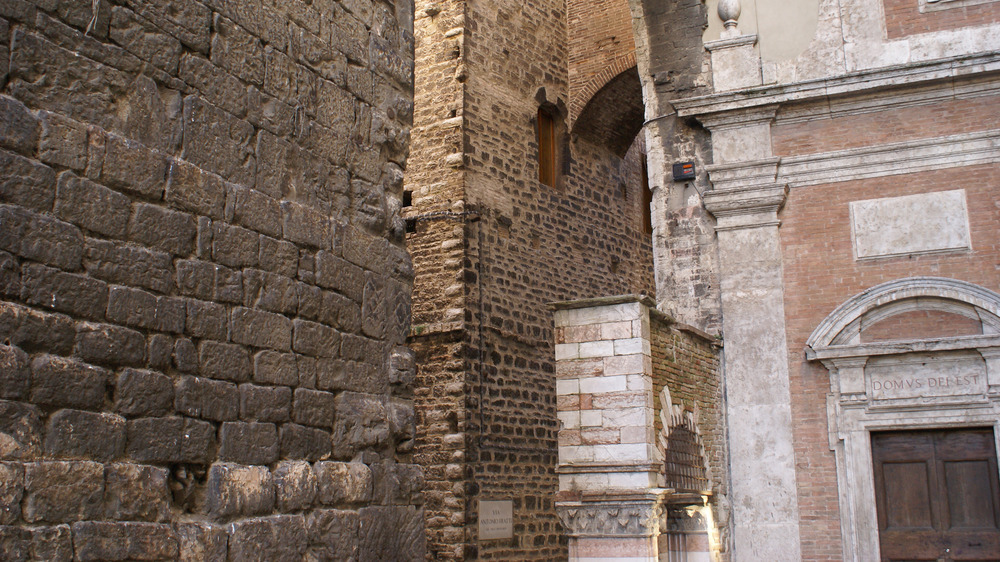This Is Why Michelangelo Hid Under The Medici Chapel For 3 Months
It was 1975 when the Medici Chapel Museum director, Paolo dal Poggetto, stumbled across a small trapdoor obscured by a wardrobe. Behind it, a steep stone staircase led to a basement room that nobody knew was there for hundreds of years. On the walls were beautiful charcoal drawings hidden amidst layers of dirt and mold, and some were unmistakable. These were the drawings of Michelangelo di Lodovico Buonarroti Simoni.
Michelangelo is one of the Renaissance's most beloved creators. He sculpted some of the period's most iconic works, including the David in Florence, Italy, and the Madonna of Bruges in Belgium. The artist was well-rounded, able to create masterpieces in most media. Vatican City's Sistine Chapel is one of his most famous works, over 5,000 square feet of frescoes across the ceiling and the altar wall, filled with images reflecting stories from biblical texts. As Michelangelo.org points out, the artist's talents extended to architecture, including the design of St. Peter's Basilica, Palazzo Farnese, and several other notable buildings.
Michelangelo is one of few artists who was famous during his own lifetime, and, apparently, he spent a portion of that lifetime hiding in solitude. But why in the world would an artist of such acclaim, one who's still considered one of the greatest artists of all time, need to hide out beneath his own work? It turns out that Michelangelo made himself a few powerful enemies.
Michelangelo's connection to the Medici
No artist of that day could have afforded to fund the projects for which Michelangelo is famous. Instead, these works of art were funded by wealthy and powerful members of society. These folks were usually those who ran the world in which they lived. The Catholic Church funded Michelangelo's Sistine Chapel art, but the Church wasn't the only force in Michelangelo's neck of the woods — Florence, Italy. Florence was under the control of different rulers: the Medici family.
The Medici were the benefactors behind several of Michelangelo's works. As Britannica tells us, Lorenzo de' Medici, the leader of the city, had a need to be surrounded by the most creative and most intellectual people that he could track down. Michelangelo fell into this category. Florence was the place to go for all things art, and Michelangelo had made it to the top with the help of the Medici.
Sometime around 1520, according to NPR, the Medici enlisted Michelangelo to design their family's mausoleum in the Basilica of San Lorenzo. The artist did a fantastic job, carving the angelic nude images of Lorenzo and other Medici from marble among a wall of artistic pillars. Today, the Medici Chapel stands as a museum that feeds tourists a taste of Renaissance history, but for a while, it served to house Michelangelo from his benefactors.
Michelangelo goes turncoat
By 1527, the people of Florence had grown tired of the Medici family's rule. Italy was in the middle of the Italian Wars, and the ground floor of Florence wanted a more democratic form of government. As NPR points out, the people tossed the Medici out and took control of the city. Of course, the Medici family wanted Florence for themselves, so they linked up with Pope Clement VII (also a Medici) and laid siege to the city in 1529. Which side of the dispute do you think that ungrateful, no-good Michelangelo took? According to Atlas Obscura, the artist sided with the people of Florence. To be fair, it was probably the right choice.
Michelangelo put his skills to work, helping fortify the city against the family that was responsible for his fame. The siege of Florence dragged on for 10 months. The people were weary and the Medici family wasn't giving up. They had the backing of their wealth and the Church, and they could hold out as long as it took to break the people's revolt. Eventually, as Italy Magazine points out, the Medici won the altercation and regained control of their city. That meant Michelangelo, the once-beloved protégé of the Medici family, needed to get out of Dodge — well, Florence — and he needed to do it fast.
A nice, cozy hideout
This is where the hidden room under the Medici Chapel comes in. Michelangelo had designed the mausoleum and knew the Basilica of San Lorenzo better than anyone else around, so instead of fleeing the city when the Medici retook Florence, the artist climbed into the tiny room beneath the mausoleum and hid from the harsh punishments the Medici were doling out to dissenters. "I hid in a tiny cell, entombed like the dead Medici above, though hiding from a live one. To forget my fears, I filled the walls with drawings," Michelangelo said about his time on the lamb (found via The Telegraph).
The artist lived in his hidden room for three months, sketching on its walls to pass the time, but he wouldn't stay there forever. It turns out, Michelangelo wasn't necessarily the kind of dude you want in your corner. He seems to have had very little loyalty. After throwing the Medici family away like one of grandma's stale gumdrops to join the people's revolt (grandpa's hard caramels), Michelangelo switched sides again, according to Atlas Obscura, when the pope spread news that the artist wouldn't be harmed if he came out of hiding. The Medici wanted their Mausoleum finished, and they were willing to spare Michelangelo to get it.
As for Michelangelo, we wouldn't exactly trust the guy to watch our six, but he did turn the Medici Chapel into a work of art.



